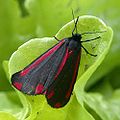- Cinnabar moth
-
Cinnabar Moth 
Scientific classification Kingdom: Animalia Phylum: Arthropoda Class: Insecta Order: Lepidoptera Family: Arctiidae Genus: Tyria Species: T. jacobaeae Binomial name Tyria jacobaeae
(Linnaeus, 1758)Synonyms - Phalaena jacobaeae
- Noctua jacobaeae
- Tyria confluens
- Callimorpha senecionis
The Cinnabar moth (Tyria jacobaeae) is a brightly coloured arctiid moth, found in Europe and western and central Asia. It has been introduced into New Zealand, Australia and North America to control poisonous ragwort, which its larvae feed on. The moth is named after the red mineral cinnabar because of the red patches on its predominantly black wings. Cinnabar moths are about 20mm long and have a wingspan of 32–42 mm (1.3-1.7 in).
Cinnabar moths are day-flying insects. Like many other brightly coloured moths, it is unpalatable; The larvae use members of the genus Senecio as foodplants. Many members of the genus have been recorded as foodplants but for long term population success the presence of the larger species such as ragwort is needed. Smaller plant species such as groundsel are sometimes used but since the species lays its eggs in large batches survival tends to be reduced. The larvae absorb bitter tasting alkaloid substances from the foodplants, and assimilate them, becoming unpalatable themselves.[1] The bright colours of both the larvae and the moths act as a warning sign so that they are seldom eaten by predators.
Like several other Arctiidae moth larvae, the Cinnabar caterpillars can turn cannibalistic. This can be due to lack of food, but they can eat other Cinnabar larvae for no apparent reason.[citation needed] Females lay up to 300 eggs, usually in clusters of 30 to 60. Initially the larvae are pale yellow but later larval stages develop the jet black and orange/yellow striped colouring.[2] They feed ravenously and can grow up to 30mm. Cinnabar caterpillars are voracious eaters and large populations can strip entire patches of ragwort clean, a result of their low predation.
Often very few survive to the pupa stage, mainly due to them completely consuming the food source before reaching maturity; this could be a possible explanation for their tendency to engage in seemingly random cannibalistic behaviour, as many will die from starvation.[citation needed]
The moth has proven to be particularly successful as a biocontrol agent for ragwort when used in conjunction with the ragwort flea beetle in the western United States.[3]
References
- ^ "Cinnabar moth". A Nature Observer′s Scrapbook. bugsandweeds.co.uk. June 2007. http://www.bugsandweeds.co.uk/moths%20p2.html. Retrieved 2007-12-21.
- ^ "Cinnabar Moth Life Cycle". HortFACT. HortNET. 1998. http://www.hortnet.co.nz/publications/hortfacts/hf401049.htm. Retrieved 2007-12-21.
- ^ Coombs, E. M., et al., Eds. (2004). Biological Control of Invasive Plants in the United States. Corvallis: Oregon State University Press, 344.
Categories:- Callimorphini
- Butterflies and moths of Europe
- Butterflies and moths of Asia
- Animals described in 1758
Wikimedia Foundation. 2010.






